新加坡地理经济文化英语介绍-Singapore
- 格式:doc
- 大小:60.50 KB
- 文档页数:6
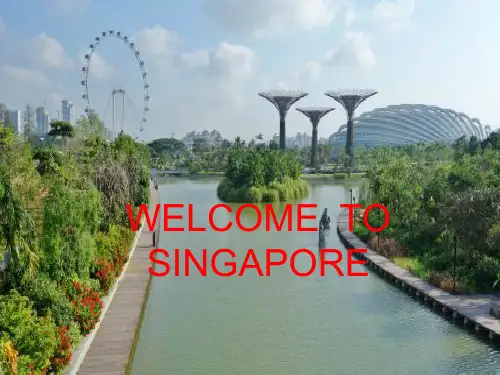
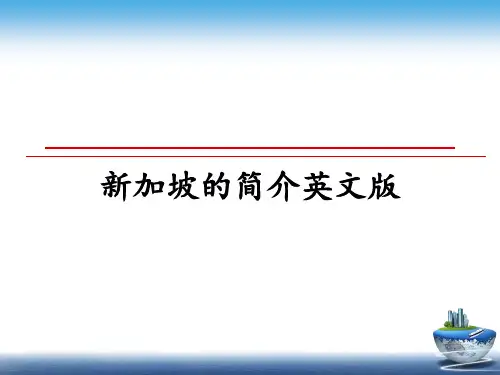
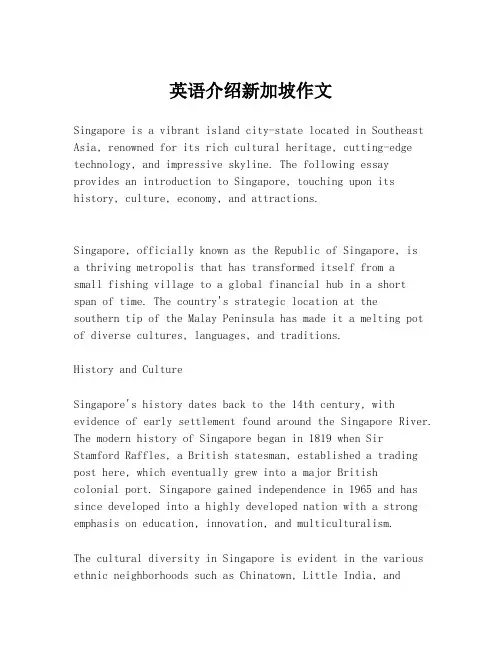
英语介绍新加坡作文Singapore is a vibrant island city-state located in Southeast Asia, renowned for its rich cultural heritage, cutting-edge technology, and impressive skyline. The following essay provides an introduction to Singapore, touching upon its history, culture, economy, and attractions.Singapore, officially known as the Republic of Singapore, isa thriving metropolis that has transformed itself from asmall fishing village to a global financial hub in a short span of time. The country's strategic location at thesouthern tip of the Malay Peninsula has made it a melting pot of diverse cultures, languages, and traditions.History and CultureSingapore's history dates back to the 14th century, with evidence of early settlement found around the Singapore River. The modern history of Singapore began in 1819 when Sir Stamford Raffles, a British statesman, established a trading post here, which eventually grew into a major Britishcolonial port. Singapore gained independence in 1965 and has since developed into a highly developed nation with a strong emphasis on education, innovation, and multiculturalism.The cultural diversity in Singapore is evident in the various ethnic neighborhoods such as Chinatown, Little India, andArab Street. Each district offers a unique experience, from the aromatic street food to the vibrant festivals like Chinese New Year, Deepavali, and Hari Raya Aidilfitri.EconomySingapore's economy is one of the most stable and business-friendly in the world. It is a leading center for international trade, finance, and technology. The country's economic success can be attributed to its well-developed infrastructure, skilled workforce, and pro-business policies. Singapore is also a significant player in the tourism industry, attracting millions of visitors each year with its iconic attractions such as the Marina Bay Sands, Gardens by the Bay, and the Singapore Flyer.EducationEducation is highly valued in Singapore, with the government investing heavily in this sector. The country boasts a robust education system that includes well-regarded institutionslike the National University of Singapore (NUS) and Nanyang Technological University (NTU), which are consistently ranked among the top universities globally.Attractions and LandmarksSingapore is a city that never sleeps, offering a plethora of attractions for tourists and locals alike. The滨海湾花园(Marina Bay) area is a must-visit, featuring the iconic Marina Bay Sands hotel with its rooftop infinity pool, theArtScience Museum, and the stunning double helix bridge. For a taste of nature, the Gardens by the Bay offer abreathtaking display of flora and fauna, including the iconic Supertrees.CuisineNo introduction to Singapore would be complete without mentioning its culinary delights. Singaporean cuisine is a delicious blend of Chinese, Malay, and Indian flavors, with dishes like chili crab, Hainanese chicken rice, and laksa being local favorites. Food courts, known as hawker centers, are遍地开花 (ubiquitous) and offer a wide range of affordable and delectable food options.ConclusionIn conclusion, Singapore is a dynamic city that offers a unique blend of the traditional and the modern. Its rich history, diverse culture, robust economy, and commitment to excellence make it a fascinating place to explore and learn from. Whether you are a business traveler, a student, or a tourist, Singapore has something for everyone and is a testament to what a nation can achieve through vision, hard work, and unity.。
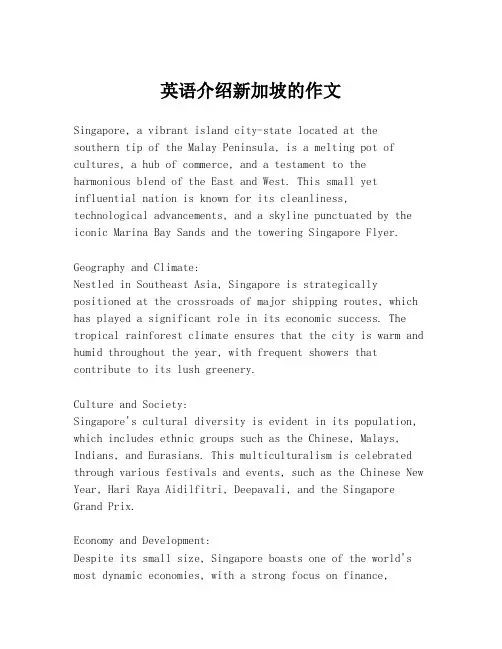
英语介绍新加坡的作文Singapore, a vibrant island city-state located at the southern tip of the Malay Peninsula, is a melting pot of cultures, a hub of commerce, and a testament to the harmonious blend of the East and West. This small yet influential nation is known for its cleanliness, technological advancements, and a skyline punctuated by the iconic Marina Bay Sands and the towering Singapore Flyer.Geography and Climate:Nestled in Southeast Asia, Singapore is strategically positioned at the crossroads of major shipping routes, which has played a significant role in its economic success. The tropical rainforest climate ensures that the city is warm and humid throughout the year, with frequent showers that contribute to its lush greenery.Culture and Society:Singapore's cultural diversity is evident in its population, which includes ethnic groups such as the Chinese, Malays, Indians, and Eurasians. This multiculturalism is celebrated through various festivals and events, such as the Chinese New Year, Hari Raya Aidilfitri, Deepavali, and the Singapore Grand Prix.Economy and Development:Despite its small size, Singapore boasts one of the world's most dynamic economies, with a strong focus on finance,electronics, and manufacturing. The country is a global financial center and is known for its low unemployment rates and high GDP per capita.Tourism and Attractions:Singapore is a popular tourist destination, offering a plethora of attractions for visitors. The滨海湾花园 (Marina Bay Gardens), with its Supertree structures and the Cloud Forest, is a must-see. The Singapore Zoo and the Night Safari provide unique experiences for wildlife enthusiasts. Additionally, the city's culinary scene is renowned for its diverse food offerings, from hawker centers to high-end restaurants.Language and Education:English is one of the four official languages, alongside Mandarin, Malay, and Tamil, reflecting the country's diverse population. Singapore's education system is highly regarded, with an emphasis on bilingual education and the development of critical thinking skills.Government and Politics:Singapore is a parliamentary republic with a strong focus on maintaining political stability and social order. Thecountry's legal system is strict, which contributes to its low crime rates and high standard of living.In conclusion, Singapore is a city-state that has successfully leveraged its strategic location, cultural diversity, and commitment to development to become a global powerhouse. Its blend of modernity and tradition, along withits dedication to progress and sustainability, makes it a fascinating place to explore and learn from.。
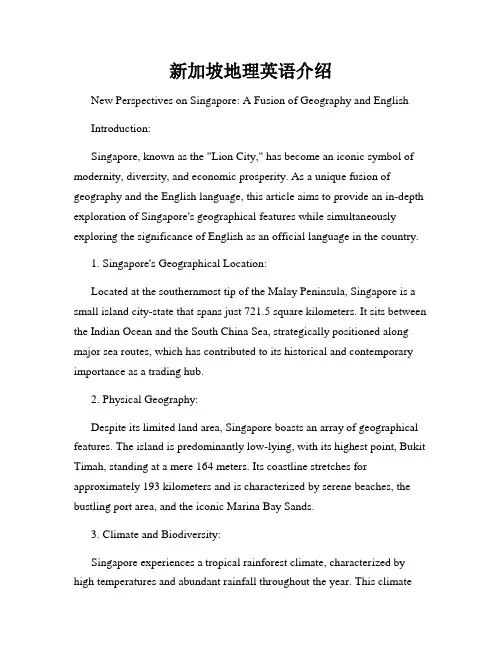
新加坡地理英语介绍New Perspectives on Singapore: A Fusion of Geography and EnglishIntroduction:Singapore, known as the "Lion City," has become an iconic symbol of modernity, diversity, and economic prosperity. As a unique fusion of geography and the English language, this article aims to provide an in-depth exploration of Singapore's geographical features while simultaneously exploring the significance of English as an official language in the country.1. Singapore's Geographical Location:Located at the southernmost tip of the Malay Peninsula, Singapore is a small island city-state that spans just 721.5 square kilometers. It sits between the Indian Ocean and the South China Sea, strategically positioned along major sea routes, which has contributed to its historical and contemporary importance as a trading hub.2. Physical Geography:Despite its limited land area, Singapore boasts an array of geographical features. The island is predominantly low-lying, with its highest point, Bukit Timah, standing at a mere 164 meters. Its coastline stretches for approximately 193 kilometers and is characterized by serene beaches, the bustling port area, and the iconic Marina Bay Sands.3. Climate and Biodiversity:Singapore experiences a tropical rainforest climate, characterized by high temperatures and abundant rainfall throughout the year. This climatesupports lush vegetation, which can be seen in its many parks and nature reserves. The island is also home to a diverse range of flora and fauna, with more than 400 bird species, 250 butterfly species, and numerous endangered plants.4. Cultural Melting Pot:Singapore's unique geography has fostered a multicultural society, where different ethnicities and religions peacefully coexist. The English language plays a vital role in connecting and unifying this diverse population. English is one of the country's four official languages, alongside Mandarin, Malay, and Tamil. It serves as a bridge between various ethnic communities, promoting understanding and efficient communication.5. Education and English:Singapore's education system places great emphasis on English proficiency. English is the medium of instruction in schools, and students are taught the language from an early age. The government's commitment to bilingual education, with a focus on English as the primary language, has contributed to the nation's high levels of English language proficiency.6. Economic Significance:Singapore's geographic location and its status as a global financial center have made English an essential language for business and trade. English acts as a language of commerce, allowing Singapore to connect with international markets and attract multinational companies. The country's proficiency in English has helped establish it as a hub for finance, technology, and innovation in Asia.7. Singapore's Global Outlook:With its multicultural society, breathtaking skyline, and booming economy, Singapore has emerged as a cosmopolitan city-state with a prominent global presence. Its strategic location, combined with its proficiency in English, makes it an important player in regional and international affairs. English proficiency continues to be a cornerstone of Singapore's efforts to maintain its global competitiveness.Conclusion:As we delve into Singapore's geography and the significance of English, it is clear that these two elements are intrinsically linked. The island's unique geographical features, coupled with its multicultural society, have shaped a vibrant nation that stands at the forefront of global development. Meanwhile, the English language acts as a common thread that weaves Singapore's diverse communities together and propels its economic success. By understanding and appreciating the fusion of geography and English in Singapore, we gain valuable insights into the country's past, present, and future.。
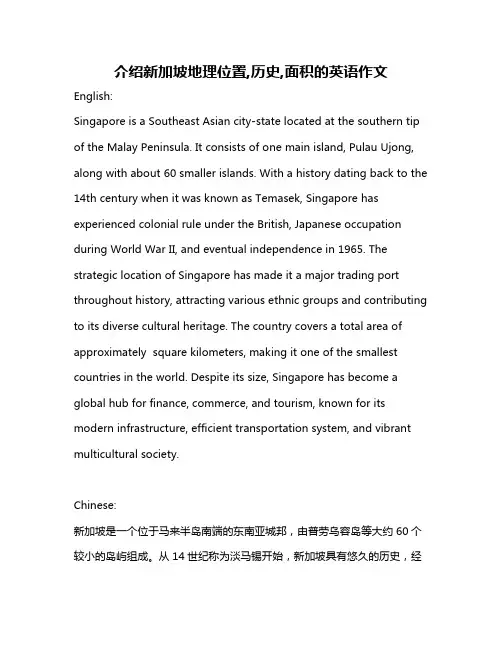
介绍新加坡地理位置,历史,面积的英语作文English:Singapore is a Southeast Asian city-state located at the southern tip of the Malay Peninsula. It consists of one main island, Pulau Ujong, along with about 60 smaller islands. With a history dating back to the 14th century when it was known as Temasek, Singapore has experienced colonial rule under the British, Japanese occupation during World War II, and eventual independence in 1965. The strategic location of Singapore has made it a major trading port throughout history, attracting various ethnic groups and contributing to its diverse cultural heritage. The country covers a total area of approximately square kilometers, making it one of the smallest countries in the world. Despite its size, Singapore has become a global hub for finance, commerce, and tourism, known for its modern infrastructure, efficient transportation system, and vibrant multicultural society.Chinese:新加坡是一个位于马来半岛南端的东南亚城邦,由普劳乌容岛等大约60个较小的岛屿组成。
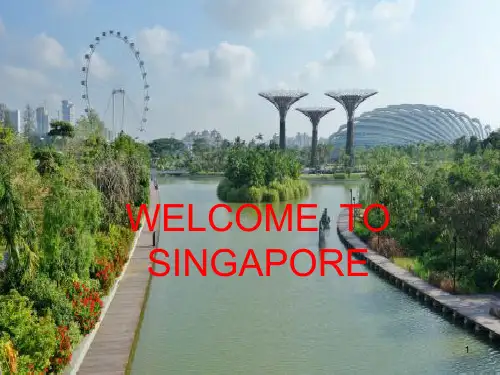


新加坡英语介绍作文English:Singapore, situated in Southeast Asia, is known for its unique blend of cultures, futuristic architecture, and efficient public transportation system. As a former British colony, English is one of the four official languages spoken in Singapore alongside Mandarin, Malay, and Tamil. The city-state is famous for its clean streets, strict laws, and diverse cuisine which reflects the multicultural society. Singapore is also a popular tourist destination with attractions such as Marina Bay Sands, Gardens by the Bay, and Sentosa Island. In addition, the country is recognized for its strong economy, high standard of living, and strong emphasis on education. Overall, Singapore is a vibrant and modern city that offers a mix of tradition and innovation.中文翻译:新加坡位于东南亚,以独特的文化融合、未来主义建筑和高效的公共交通系统而闻名。
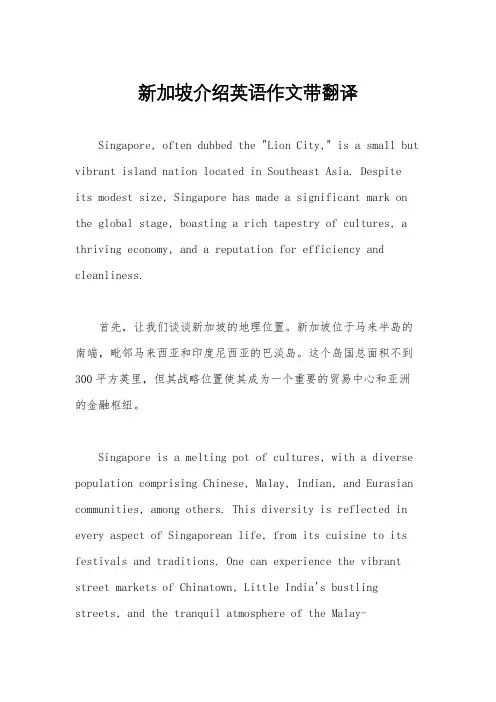
新加坡介绍英语作文带翻译Singapore, often dubbed the "Lion City," is a small but vibrant island nation located in Southeast Asia. Despiteits modest size, Singapore has made a significant mark on the global stage, boasting a rich tapestry of cultures, a thriving economy, and a reputation for efficiency and cleanliness.首先,让我们谈谈新加坡的地理位置。
新加坡位于马来半岛的南端,毗邻马来西亚和印度尼西亚的巴淡岛。
这个岛国总面积不到300平方英里,但其战略位置使其成为一个重要的贸易中心和亚洲的金融枢纽。
Singapore is a melting pot of cultures, with a diverse population comprising Chinese, Malay, Indian, and Eurasian communities, among others. This diversity is reflected in every aspect of Singaporean life, from its cuisine to its festivals and traditions. One can experience the vibrant street markets of Chinatown, Little India's bustling streets, and the tranquil atmosphere of the Malay-influenced Kampong Glam all within a single day.新加坡的经济也是其引以为豪的一大特点。
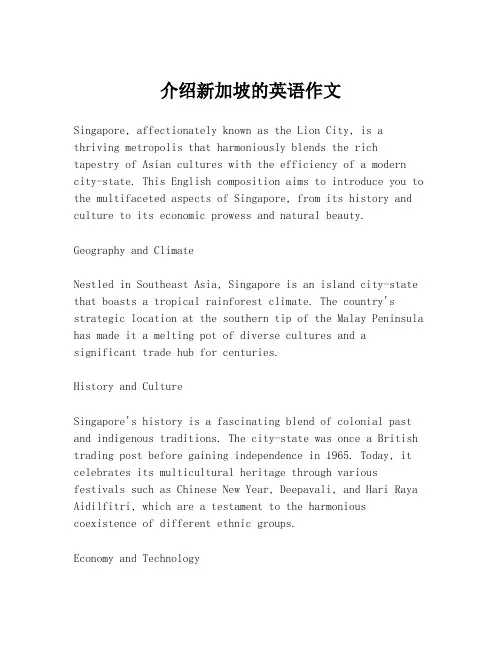
介绍新加坡的英语作文Singapore, affectionately known as the Lion City, is a thriving metropolis that harmoniously blends the rich tapestry of Asian cultures with the efficiency of a modern city-state. This English composition aims to introduce you to the multifaceted aspects of Singapore, from its history and culture to its economic prowess and natural beauty.Geography and ClimateNestled in Southeast Asia, Singapore is an island city-state that boasts a tropical rainforest climate. The country's strategic location at the southern tip of the Malay Peninsula has made it a melting pot of diverse cultures and a significant trade hub for centuries.History and CultureSingapore's history is a fascinating blend of colonial past and indigenous traditions. The city-state was once a British trading post before gaining independence in 1965. Today, it celebrates its multicultural heritage through various festivals such as Chinese New Year, Deepavali, and Hari Raya Aidilfitri, which are a testament to the harmonious coexistence of different ethnic groups.Economy and TechnologySingapore's economy is one of the most dynamic and innovative in the world, with a strong focus on finance, electronics, and biotechnology. The city is a global financial center and a pioneer in technological advancements, making it an attractive destination for businesses and investors alike.Education and LanguageEnglish is one of the four official languages in Singapore, alongside Mandarin, Malay, and Tamil. The country places a high premium on education, with a robust system that includes prestigious institutions like the National University of Singapore and Nanyang Technological University. English is widely used in business and education, making it an essential tool for communication and integration.Tourist AttractionsSingapore is a haven for tourists, offering a plethora of attractions. The iconic Marina Bay Sands, the vibrant Clarke Quay, and the lush Gardens by the Bay are just a few of the must-visit places. The city's rich culinary scene, featuring a fusion of Chinese, Malay, and Indian cuisines, is another draw for food lovers.Conservation and Green InitiativesSingapore is committed to sustainability, with numerous green initiatives that have earned it the nickname "Garden City." The city's skyline is punctuated by skyscrapers with green roofs, and its streets are lined with lush parks and gardens,showcasing a harmonious blend of urban development and environmental conservation.ConclusionIn conclusion, Singapore is a city-state that offers a unique blend of tradition and modernity, culture and commerce, and nature and technology. It is a place where the East meets West, where the past and the future coexist, and where the spirit of innovation and diversity is palpable. Whether you are a history buff, a food enthusiast, or a nature lover, Singapore has something for everyone, making it a destination that should be on every traveler's list.。
新加坡介绍英文作文Singapore, often referred to as the Lion City, is a small island city-state located in Southeast Asia. Despite its modest size, Singapore boasts a rich history, vibrant culture, and remarkable economic success. In this essay, I will delve into various aspects of Singapore, from its history and geography to its economy, culture, and modern-day significance.First and foremost, Singapore's history is a tapestry woven with diverse threads. Originally inhabited by indigenous Malays, Singapore's strategic location at the southern tip of the Malay Peninsula made it a coveted territory. In the early 19th century, it became a British trading post and later a colony. However, Singapore's journey to independence was not without challenges. It was briefly occupied by the Japanese during World War II before gaining self-governance in 1959 and full independence in 1965. Since then, Singapore has emerged as a beacon of stability and prosperity in the region.Geographically, Singapore is a tiny island nation spanning just over 700 square kilometers. Despite its limited land area, Singapore has managed to maximize its space through meticulous urban planning and innovative architecture. The iconic Marina Bay Sands, Gardens by the Bay, and the Supertree Grove are testaments to Singapore's ability to blend nature with modernity seamlessly.Economically, Singapore punches above its weight. It is a global financial hub and one of the busiest ports in the world. Its economy is driven by trade, finance, and manufacturing, with key industries including electronics, biomedical sciences, and logistics. Singapore's success as a business destination can be attributed to its strategic location, efficient infrastructure, pro-business policies, and skilled workforce.Beyond its economic prowess, Singapore's cultural landscape is incredibly diverse. It is a melting pot of different ethnicities, including Chinese, Malay, Indian, and Eurasian communities. This cultural tapestry isreflected in Singapore's cuisine, language, festivals, and traditions. The vibrant streets of Chinatown, Little India, and Kampong Glam offer a glimpse into Singapore's multicultural fabric.Moreover, Singapore places great emphasis on education and innovation. It boasts world-class universities, research institutions, and a robust ecosystem for startups and technology companies. The government's commitment to investing in human capital and fostering innovation has propelled Singapore onto the global stage as a leader in technology and research.In addition to its economic and cultural significance, Singapore plays a pivotal role in regional and global affairs. It is a member of various international organizations, including ASEAN, the United Nations, and the World Trade Organization. Singapore's foreign policy is guided by principles of pragmatism, diplomacy, and neutrality, allowing it to navigate complex geopolitical dynamics effectively.In conclusion, Singapore is much more than just a small island nation. It is a testament to the power of resilience, innovation, and diversity. From its humble beginnings as a fishing village to its status as a global economic powerhouse, Singapore's journey is one of inspiration and aspiration. As the Lion City continues to roar onto the world stage, its story serves as a beacon of hope and possibility for nations around the globe.。
Title: Singapore: A Unique City-State at the Heart of Southeast AsiaNestled at the heart of Southeast Asia, Singapore is a city-state renowned for its strategic location, rich history, and diverse cultural fabric. This tiny yet vibrant nation boasts a unique identity that sets it apart from the rest of the world.Geographically, Singapore occupies a prime position at the southern tip of the Malay Peninsula, situated just north of the equator. Its strategic location at the crossroads of the Indian Ocean and the Pacific Ocean has enabled Singapore to become a global hub for trade, finance, and cultural exchange. Surrounded by the Singapore Strait and the South China Sea, the city-state consists of a main island and numerous smaller islands, covering an area of approximately 735.2 square kilometers. Despite its small size, Singapore boasts a high population density, with over 5.6 million inhabitants.The history of Singapore is as fascinating as its present-day grandeur. Originating from a small fishing village, Singapore was founded in the 14th century by the Malay sultanate. Over the centuries, the island changed hands several times, passing through the hands of various powers including the British East India Company and ultimately becoming a British colony in 1824. This colonial period saw the emergence of Singapore as a major port and trading center, attracting merchants and immigrants from all over the world.Post-independence in 1965, Singapore embarked on a journey of rapid economic growth and development. Its political stability, sound economic policies, and strategic location have contributed to its success as a global financial and business hub. Today, Singapore is home to a vibrant multicultural society, with a blend of Asian and Western influences that give the city-state its unique charm.In conclusion, Singapore is a unique city-state that owes its success to its strategic location, rich history, and dynamic society. This tiny yet powerful nation continues to play a significant role in the global arena, serving as a bridge between East and West and a beacon of progress and prosperity in Southeast Asia.。
Singapore: A Unique City-State at the Heartof Southeast AsiaNestled in the heart of Southeast Asia, Singapore stands as a unique city-state, boasting a rich history, strategic geographical location, and a compact yet vibrant landscape.Geographically, Singapore occupies a strategic position at the southern tip of the Malay Peninsula, just north of the equator. It lies at the crossroads of the Indian Ocean and the Pacific Ocean, connecting the East and West, and serving as a gateway for trade and cultural exchange. This prime location has enabled Singapore to develop into a global hub for finance, technology, and innovation.Historically, Singapore's journey began with its founding by the Malay sultanate in the 14th century. Over the centuries, the island changed hands several times, passing through the hands of various powers including the Dutch, the British, and the Japanese. In 1965, Singapore gained its independence from Malaysia, emerging as a sovereign nation-state within the British Commonwealth. Since then, it has transformed into a modern, progressivecountry, renowned for its political stability, economic prosperity, and social harmony.In terms of area, Singapore is relatively small, covering just over 730 square kilometers. Despite its size, however, the island nation punches above its weight in terms of diversity, culture, and achievements. Its compact size belies a robust infrastructure, a green and lush urban landscape, and a vibrant multicultural society.Singapore's unique geographical location, richhistorical heritage, and compact yet dynamic landscape have all contributed to its status as a global powerhouse. As it continues to evolve and adapt to the challenges of the 21st century, Singapore remains a beacon of hope and inspiration for the world.**新加坡:东南亚之心的独特城市国家**新加坡坐落于东南亚的中心地带,作为一个独特的城市国家,以其丰富的历史、战略性的地理位置以及紧凑而充满活力的景观而闻名。
新加坡地理经济文化英语介绍新加坡共和国Republic of SingaporeSingapore, officially the Republic of Singapore, is an island country located at the southern tip of the Malay Peninsula. It lies 137 kilometres (85 mi) north of the equator, south of the Malaysian state of Johor and north of Indonesia's Riau Islands. At 707.1 km2 (273.0 sq mi), Singapore is one of four remaining true city-states in the world. It is the smallest nation in Southeast Asia.Prior to European settlement, the island now known as Singapore was the site of a Malay fishing village at the mouth of the Singapore River. Several hundred indigenous Orang Laut people also lived along the nearby coast, rivers and on smaller islands. In 1819 the British East India Company established a trading post on the island, which was used thereafter as a strategic trading post along the spice route.[4] Singapore would become one of the most important commercial and military centres of the British Empire, and the hub of British power in Southeast Asia. The city was occupied by the Japanese during World War II, which Winston Churchill called "Britain's greatest defeat".[5] Singapore reverted to British rule immediately postwar, in 1945. Eighteen years later the city, having achieved independence from Britain, merged with Malaya, Sabah and Sarawak to form Malaysia. However, less than two years later it seceded from the federation and became an independent republic on 9 August 1965. Singapore joined the United Nations on 21 September that same year. It is also a member of the Commonwealth of Nations.Since independence, Singapore's standard of liv ing has been on the rise. Foreign direct investment and a state-led drive to industrialisation based on plans drawn up by the Dutch economist Albert Winsemius have created a modern economy focused on electronics manufacturing, petrochemicals, tourism and financial services alongside traditional entrepôt trade.[citation needed] Singapore is the 5th wealthiest country in the world in terms of GDP (PPP) per capita.[6] This small nation has foreign exchange reserves of more than US$177 billion.[7]The population of Singapore is approximately 4.84 million.[2] Though Singapore is highly cosmopolitan and diverse, ethnic Chinese form the majority of the population. English is the administrative language of the country.The Constitution of the Republic of Singapore established the nation's political system as a representative democracy, while the country is recognised as a parliamentary republic.[8] The People's Action Party (PAP) dominates the political process and has won control of Parliament in every election.新加坡自然地理Nature Geography 1位于东南亚,是马来西亚半岛最南端的一个热带城市岛国。
面积为693平方公里,北隔柔佛海峡与马来西亚为邻,有长堤与马来西亚的新山相通,南隔新加坡海峡与印度尼西亚相望。
Singapore physical geography is located at Southeast Asia, is a Peninsular Malaysia most south tip of tropics city island country. The area is 693 square kilometers, north separates the Johore channel and Malaysia is the neighbour, has the causeway and Malaysia's Joho re is interlinked, south separates the Singapore channel and Indonesia faces one another新加坡国名由来How Did Singapore Get Its Name2加坡是一个城市国家,原意为“狮城”。
据马来史籍记载,公元1150年左右,苏门答腊的室利佛逝王国王子盘那乘船到达此岛,看见一头猛兽,当地人告知为狮子,遂有“狮城”之称。
新加坡是梵语“狮城”之谐音,由于当地居民受印度文化影响较深,喜欢用梵语作为地名。
而狮子具有勇猛、雄健的特征,故以此作为地名是很自然的事。
过去华侨多称其为“息辣”,即马来语“海峡”的意思,也有因其小而将之称为星洲、星岛的。
图为新加坡的标志与象征——鱼尾狮塑像和“新加坡国父”---李光耀。
Singapore is a city state, the original intention is “Singapore”. According to Malaya the historical records record, about 1150, Sumatra's room advantage Buddha passed kingdom prince plate that to go by boat to arrive at this island, saw a beast of prey, the native to inform for the lion, then had “Singapore” the name. Singapore is Pali “Singapore” the harmonics, because the local resident is been deep the Indian culture influence, likes taking the geographic name with Pali. But the lion has, the vigorous characteristic fiercely, therefore by this achievement geographic name is the very natural matter. In the past overseas Chinese multi-name it “the Singapore”, namely Mala y “channel” meaning, also had because of its slightly, but will be called Singapore, Sing Tao. The chart makes an idol for Singapore's symbol and the symbolic - - fish tail lion with “the Singapore father”---Lee Kuan Yew.面积Area measurement :为693平方公里693 square kilometers t 3首都Capital:新加坡(Singapore)独立日Independence Day:8月9日(1965年)官方语言official language :英语、汉语、马来语、泰米尔语English, Chinese, Ma lay, Tamil language行政用语:英语汉语(2006年起汉语也可作为政府行政语言)Administrative terminol ogy: English Chinese (in 2006 Chinese may also take government administration language国家格言:Majulah Singapura(前进吧,新加坡”Advance, Singapore国歌:Majulah Singapura 前进吧,新加坡Advance, Singapore国语National language :马来语Malay国花national flower :以一种名为卓锦·万代兰的胡姬花为国花。